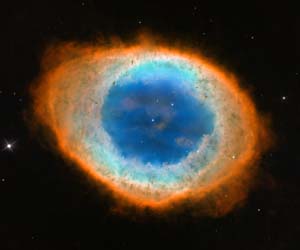The Ring Nebula is a planetary nebula, these type of nebula are created when a small star sheds it mass at the end of its life span.
The core of the dead star remains in the form of white dwarf, it ionizes the surrounding gas producing an impressive light display.
The original star that created the Ring Nebula is thought to have been several times more massive than our sun but not large enough to explode as a supernova.
The event that produced the Ring Nebula is estimated to have occurred around 4,000 years ago .
The different colors produced by the Ring Nebula are the result of temperature differences, the hot inner gas is blue whereas the cooler outer gas is red.
The Ring Nebula is around 1 light year across and is expanding at a rate of 1.5 million kilometers per day.
The Ring Nebula will grow 50% larger in diameter over the next few thousand years before it begins to fade and disperse.
The Ring Nebula is approximately 2,000 light years from Earth.
In January 1779 the Ring Nebula was discovered by the little known French astronomer Antoine Darquier de Pellepoix. Coincidentally a few weeks later another French astronomer Charles Messier, who was unaware of Pellepoix’s discovery, listed the nebula in his catalogue of deep sky objects as Messier 57. Messier was unaware of what the object actually was, he concluded that it was a group of dim stars.
It wasn’t until the late 19th century that the true nature of these objects began to be revealed. After observing the Ring Nebula and other similar objects the British astronomer William Huggins concluded that they were not composed of stars at all but of luminous gas. In the late 20th century the true nature of the Ring Nebula’s beauty was revealed by the Hubble space telescope, its colorful display making it one of the most spectacular objects in our galaxy. Observations of the Ring Nebula continue to reveal secrets of these fascinating objects.
Statistics⏩⏩⏩⏩
Also Known As: M57, Messier 57, NGC 6720
Distance from Earth: Approx 2,000 light years
Nebula Type: Planetary Nebula
Constellation: Lyra
Span: Approx 1 light year
Apparent Magnitude: +8.8
Discovery Date: 1779












0 Comments